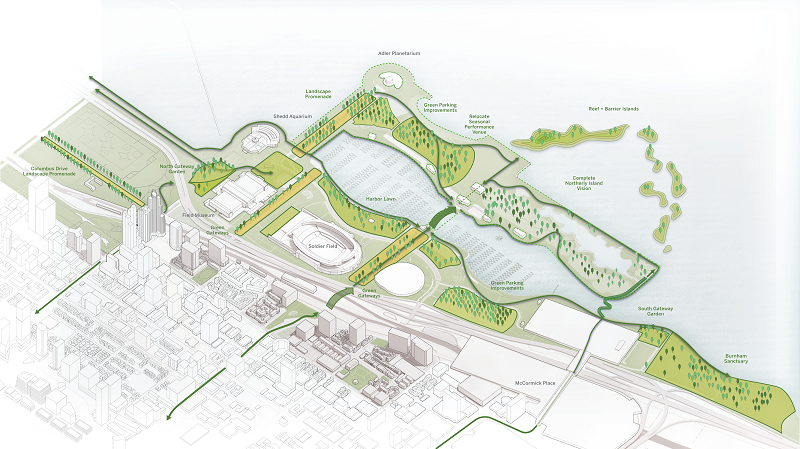Home
Where Worlds Connect
A New Vision for the Museum Campus




Transformational place-making with enhanced programming and amenities will activate currently underutilized spaces and buildings across the Museum Campus to enrich the visitor experience. A renewed Soldier Field will deliver a world-class visitor experience in and around the stadium, and, along with Lakeside Center, anchor a vibrant entertainment corridor. With a greater diversity of experiences that expand use of the Campus throughout the day and into the evening, visitors will want to linger on the Campus and return often.
The following diagram illustrates how the working group envisions amenities for campus visitors and programming activating the Campus. Rethinking the use of Solidarity drive will open a new and vibrant core for the Campus connecting the three museum and leveraging its’ spectacular location facing the Chicago skyline. By concentrating amenities along Solidarity Drive, Burnham Harbor, and the western half of the Museum Campus, Northerly Island can be preserved as a natural oasis and attract visitors to enjoy 12th Street Beach and immerse themselves in nature.

The transformative power of landscaping with native species will amplify the natural beauty of the Museum Campus, creating a destination where visitors can immerse themselves in nature. Far more than simply filling the spaces between institutions, it will tie the Campus together, improve its function as a major flyway stop, and make it a model for sustainability. Paired with innovative approaches to environmental preservation, the Museum Campus will demonstrate Chicago’s role as a leader in urban climate resilience.
The diagram below illustrates the key elements of the vision for making the Campus an urban nature retreat including reclaiming and activating green spaces on Northerly Island and around the harbor, greening and beautifying surface parking areas, expanding the landscaping efforts initiated by the Field Museum and the Shedd Aquarium along Solidarity Drive, and creating reef barriers as originally envisioned to protect Northerly Island from lake erosion.

New amenities, inclusive design, and coordinated programming will create a Museum Campus that attracts and welcomes all, from each Chicago neighborhood to our neighbors from across the world. To attract and be relevant to all, features and programming will appeal and be accessible to people with different interests, lifestyles, and needs. Access to the Campus will go beyond physical connections and extend to building a true sense of belonging and ownership.
World-class connectivity will take full advantage of all modes of mobility to connect Chicago’s neighborhoods, the Chicagoland region, and the world to the Campus. Whether for daily access or a special event, transportation to and from the Campus will be more convenient and enjoyable, while disruptions to major transit corridors and adjacent communities will be minimized. Visitors will have a distinct sense of arrival regardless of how they access the Campus and be greeted by new and exciting ways to move around the Campus.
As illustrated below, a more easily accessible Campus leverages all modes of travel to the north, west, and south. Pedestrian access over the railroad tracks and improved connections through McCormick Center increase connectivity to the west. Expanded use of the McCormick Place Busway, water taxis, and Metra increase access to the north and south. Two main mobility hubs convey a sense of arrival and make it easy to transfer between on-Campus modes of transportations while new bridges make Northerly Island more accessible from the west and south and improve circulation on the campus.

The vision for the Campus will be pursued in a coordinated way that maximizes the mutually reinforcing aspects of individual recommendations to compound the benefits of future investment. Coordinating these efforts with a dedicated body will give the Campus a more cohesive identity, make it more sustainable, and ensure its longevity as an attractive, year-round destination for everyone.

Explore the Full Report
